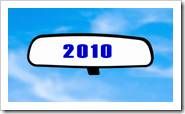 In many ways, 2010 was the start of a return to normalcy. Interest rates began their slow march back to sustainable levels, non-insured mortgage options returned to the marketplace, and private default insurers re-asserted themselves.
In many ways, 2010 was the start of a return to normalcy. Interest rates began their slow march back to sustainable levels, non-insured mortgage options returned to the marketplace, and private default insurers re-asserted themselves.
In other ways, 2010 was atypical. The government enacted sweeping new mortgage rules, banks competed far more aggressively, and mortgage rates yo-yo’d back to all-time lows despite widespread predictions otherwise.
Among these developments came five of the year’s top mortgage trends:
1. New Mortgage Guidelines
In an effort to pre-empt excessive borrowing, the government imposed far-reaching new mortgage rules. That made it harder to qualify for a variable-rate mortgage, harder to consolidate debt, harder to get a rental property mortgage, and harder for self-employed homeowners to qualify for high-ratio financing.
Despite moderating home prices and low default-rate projections, some felt April’s rule changes weren’t enough. As 2010 drew to a close, a small contingent called for even more government regulation. (Thus far, the Finance Department hasn’t publicly supported more regulation, so the odds of new rules in 2011 are off the board.)
2. Astonishing Rates
Mortgage rates made historic lows in 2010. Homeowners jumped at 3.29% five-year fixed mortgages and variables below 1.75%.
In turn, rock-bottom rates and extended amortizations stoked home demand (some say over-stoked) with monthly payments as much as 30% below long-term averages for the same mortgage amount.*
Giveaway rates had to end sometime, however. After prime rate held at 2.25% for over 13 months, the long and slow climb to a “normal” policy rate began in June.
3. Banks Stepped Up Their Game
Banks kept up an assault on brokers that began in earnest in 2009.
In 2010, banks fought harder than ever with aggressive discounting. BMO’s Low Rate mortgage and CIBC’s cash-back switch (with its low effective rate) were two very public examples. Behind the scenes, banks armed their internal mortgage sales forces with an ever-greater amount of rate discretion.
The Big 5 also put more bodies on the street, with some swelling their mortgage specialist ranks by 20-30%. Banks even tried to steal a page from broker playbooks by promoting comprehensive mortgage advice.
4. Cross-winds in the Broker Channel
2010 was the first year in many that overall broker market share declined somewhat, ending at about 25%. The industry-wide broker headcount also reportedly fell. Bank and credit union competition and rate-driven mortgage commoditization were two leading causes.
On the other hand, 2010 saw brokers capture the biggest share of new mortgages at 40%. (This is a very positive continuation of a long-term trend.)
5. Changing Nature of Posted Rates
Instead of raising posted and discounted rates simultaneously, banks (led by RBC) deviated from tradition in late 2010. As client rates rose, banks held down posted rates. The banks’ stated objective was to appear more competitive, but the sub-plots were more interesting. Suppressing posted rates had major implications for:
- Qualification rates (making 1-4 year terms and variables easier to get)
- IRD penalties (which, at some lenders, would have decreased if posted rates had risen)
- Cash-back down payment mortgages (which are sold at posted rates and got relatively cheaper)
**********
This brings us to a not-so-fearless prognostication for 2011.
We have a strong sense that lower volume and easier-to-access rate data will trigger ferocious rate competition in 2011 (but not savage rate competition. Wait until 2012 for that). Banks and credit unions will battle even harder for share, and give their legions of new specialists more ability to compete on rates. Add in a slew of new rate comparison websites and 2011 may be the greatest test yet for mortgage originators.
Sidebar: For experienced mortgage planners and road reps with big client databases, rate wars are less of a concern, however for newer originators building a referral network, they represent a threat.
Competition need not be unnerving but it should be motivating. Developing an information advantage (i.e. finding creative ways to deliver better advice)…and executing on time-tested and/or unique referral strategies…will help keep you on top of the game.
* Based on a static loan amount and comparing a 3.50% 5-year fixed with a 35-year amortization versus a 5.15% 5-year fixed with a 25-year amortization. 5.15% is an approximate 10-year average of discounted 5-year fixed rates.
Rob McLister, CMT







Worth adding that the “small contingent” calling for more regulation includes some nobody named Mark Carney.
Carney is worried about debt in general, which includes consumer debt. He has not asked for more mortgage regulation.
Great lookback. I agree this will be a good year for mortgage consumers. I just hope people remember there is more to a mortgage than the interest rate!
6) Battle of the media “experts” discussing the housing market bubble
There is a constant sping machine going, with new data being released seemingly every week saying that either the Canadian Market is due for a correction or it’s “balanced”. Everyone has their opinion: from Flaherty and Carney to Garth Turner and Benjamin Tal, to Will Dunning and Cameron Muir.
Paul,
Please answer my stupid question:
Are you saying that Carney is more concerned with the leather, coffee table ottoman I bought with my BMO mastercard or the mortgage on my rental triplex?
Dislike being juvenile but your comment is misleading so I felt the need to respond in kind. A B of C governor can only say so much and must be circumspect, given that standard, what he said was pointed: tighter mortgages.
Hi Caroline, Me too. Since lenders can only go so low on rate, we’ll probably see a lot more marketing in 2011 promoting advice. That should help a bit.
Cheers…
He is far more concerned with your coffee table ottoman on your BMO Mastercard because, chances are, it’s not alone on that card, along with your last vacation, not to mention your car loan and a bathroom reno on your LOC that are all at much higher rates than your mortgage.
That may not be your situation, but it is the situation for many (unfortunately) irresponsible Canadians, often those at the highest risk.
When the going gets tough, we all know which debt will be paid first and which will be carried over and over, paying only the minimum each month. That’s what’s going to trigger the debt tsunami.
To add re: Tomas…your comment is rational at first blush, from someone who is likely thoughtful and reasonable with regard to their financial affairs. But Carney isn’t worried about people like you or me (hopefully! haha).
He’s worried about people who are relying too heavily on their other sources of credit – ones used for purchases that generate little to no long-term equity; purchases made at interests rates that are not only higher than mortgages, but also largely beyond his sphere of influence. That’s the key.
People are going to do everything they can to make sure that the money is there for the lender to take out every month. The mortgage payment is a forced ritual that the owner barely even takes part in.
The problem is the riskier borrowers are going to make sure this money is there by “temporarily” shifting additional costs to those other sources of credit – sources of credit they’re already heavily relying on.
Considering that many people use their credit cards for everything from major purchases to recreational pursuits, from gas and groceries to emergency borrowing; considering that they DIY/reno boom has encouraged more and more homeowners to make improvements funded from LOCs; considering that, for some reason, many people today view former luxuries as today’s essentials (high-end electronics, vacations, etc.) and these are often funded from credit, this is a major major problem if/when the housing market cools off.
Now, compensating by putting more on credit is an extremely stupid thing to do, but that’s what is going to trigger the credit crisis, as risky borrowers pile on additional debt to credit sources with high interest rates that allow first bare-minimum payments, practically in perpetuity.
My top prediction of 2011 is that TD loses volume from brokers. I haven’t heard any broker say positive things about TD since they switched to collateral mortgages. In fact, I wouldn’t be suprised if TD loses volume in the retail channel too.
Looking forward, will we see finally see Peer to Peer mortgages establishing a foot hold in Canada during 2011 ?
TD’s change to a collateral charge is potentially a poison pill for both brokers and consumers. I don’t anticipate funding a single mortgage through them this year.
Regards,
Joe
What does CMT think the winds of fate have in store for the non-big 6 lenders in 2011?
An informed opinion from the front lines would be interesting.
Hi Stephen, Is there anyone doing this now? CommunityLend is interesting, but their amortization/term/loan max. have been too small to support mortgage lending. Perhaps that will change eventually. Cheers, Rob
Hi Tomas,
Banks are in the catbird seat because they have tons of low-cost cash (e.g., grandma’s 0.30% interest savings account). Non-deposit-taking lenders don’t have that edge.
That said, banks may face more heated competition this year from CUs, non-banks, and brokers. Moreover, many expect mortgage volume growth to flatline or decline this year. As a result, banks might see their mortgage interest margins compress a bit further. (This assumes no more financial crises of course.)
The thing we’re most curious about is whether any of the other Big 6 will compete publicly against BMO’s Low Rate mortgage. That could impact (sharpen) pricing industry-wide.
Cheers,
Rob
Hey Rob,
Thanks for the information.
BMO, in my perception, is the most aggressive seeker of retail business. I expect them to remain at the front of the rate wars. Perhaps to the point of encroaching on the larger “micro-lenders” out there. My outside bet is that “micro-lending” undergoes consolidation in 2011 – we’ll see.
Please indulge me with another “insider” tidbit if you’re willing. Presumably you place most of your deals with “micro-lenders” Do any of your mortgage clients express concern over the going-concern status of a particular “micro-lender” (ie. will this lender be around in 2016 when it’s time to renew)?
Hi Tomas,
Totally agree about BMO.
Our volume is spread all over the place and is allocated based on which lender has the best deal for our clients. Our top 3 lenders are major banks, primarily because they frequently offer our clients the best rates and products. However, that may change as non-bank lenders like Merix and MCAP get more aggressive.
I don’t foresee much consolidation in 2011 but there’s always the chance for exceptions. It seems that if non-banks can make it through one of the worst financial crisis in history they can weather anything. Moreover, as additional funding sources open up to non-banks it’ll help them significantly.
Long story short, Canada’s established monoline lenders are quite sound so it’s really a non-issue for most borrowers.
Cheers…
Rob,
Very interesting! I thought mortgage brokers were the sole distribution channel of micro players. It’s a pleasure to learn something new.
These micro players are small (market cap < 400M) so I assume the big 6 don't care much about them. With such low market caps micros could be blotted out in an instant. Seemingly, the big 6 don't mind the micros grinding out a living on the table scraps. Refreshing benevolence. Fascinated by your comment about new capital sources opening up for the little guys. My understanding is most of their activity is characterized by NHA securitizations. Any borrowing they do is almost solely to meet capital ratios rather than fund retail lending. Equitable did a 6% debt issue in Dec...6%?!!?...ouch!!! Man, borrowing short term and securitizing NHA is a heckuva of a juggling routine but it earns (per public financials) and undoubtedly makes life interesting for these fellows!
$ is $! interest rate is the most important aspect of a mortgage!
Rate means nothing if you choose the wrong term or if mortgage restrictions cost you more than what you save on the rate.
1.Interest rates for fixed five year mortgages will not go up or down more than .5 of a percentage in Canada during the next 12 months. Prime rate will increase by .5 to 1.0 percent but continuing competitive pressures will drive down fixed mortgage rates, and fierce rivalry between the banks will mean continuing dominance by balance sheet lenders in the first mortgage marketplace.
2. There will be increased capital available in the secondary mortgage markets, that is, the near bank and institutional lenders other than banks will find themselves under considerable pressure to lower rates or provide more innovative services and products, such as the “You’re the Boss,” mortgage recently introduced in British Columbia Lower Mainland markets by the second largest credit union in BC.
3. Investments in mortgage investment corporations will increase dramatically during 2011 due to continuing low interest dividends and interest payments available from Canadian banks and other secured lenders. A new distribution channel for MICs will expand public awareness of the mortgage investment opportunities, and MICs across Canada will expand by 50% or more during the next 12 months.
4. Real estate will increase in price across Canada, and, contrary to most prognosticators, I believe that housing prices will rise more than 5% in Greater Vancouver during 2011, with increases accelerating during the first part of the year, and slowing during the last quarter. House pricing in Alberta will increase at more than double the rate experienced in Greater Vancouver in major urban markets, with Calgary leading the country in increased prices (over 15%) during 2011.
5. (a) Dominion Lending will continue to grow faster than any other national brokerage company, and will continue its dominance in the Canadian mortgage awards. (b) Two existing national mortgage brokerage brands will virtually disappear in 2011. (c) Dominion Lending will expand into at least one other national marketplace, possibly Australia or England. (d) The United States will be targeted for expansion in 2012 or 2013. (e) Dominion Lending will have more than 2500 brokers before the end of 2011.
http://www.facebook.com/l.php?u=http%3A%2F%2Fgoo.gl%2FwA7T6&h=c3abb
Hi Donald, You’re probably very right about the rise of MICs. It would be interesting to hear what new distribution channels you foresee arising. Having more institutions pushing them could have a very positive effect on MICs. The issue I hear from some of them is that there’s not enough good deals to lend on. It’ll be interesting to see if that and a greater supply of capital waters down returns somewhat. -rm
I don’t know why Virgin haven’t thrown there hat into the ring yet. There’s been plenty of “reports”. I know a few accountants in the micro-lending space, but it’s not on any scale. The basic concept is brilliant.
Do you always buy the cheapest product, regardless of other characteristics: appliances, cars … restaurant meals? Of course not. Although price is important, there are many characteristics to consider in shopping for a mortgage. As you know from other posts, pre-pay privileges, penalties and term all play a role (amongst other things). Most banks offer very limited advice to choose from the many options, and will of course offer only their own products. Ironically, how you structure your debt is an important part of building wealth; there is more to this important class of products than just price.